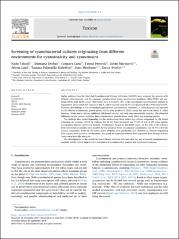| dc.contributor.author | Tokodi, Nada | |
| dc.contributor.author | Drobac, Damjana | |
| dc.contributor.author | Lazić, Gospava | |
| dc.contributor.author | Petrović, Tamaš | |
| dc.contributor.author | Marinović, Zoran | |
| dc.contributor.author | Lujić, Jelena | |
| dc.contributor.author | Palanački-Malešević, Tamara | |
| dc.contributor.author | Meriluoto, Jussi | |
| dc.contributor.author | Svirčev, Zorica | |
| dc.date.accessioned | 2019-11-04T12:39:35Z | |
| dc.date.available | 2019-11-04T12:39:35Z | |
| dc.date.issued | 2018 | |
| dc.identifier.issn | 0041-0101 | |
| dc.identifier.uri | https://repo.niv.ns.ac.rs/xmlui/handle/123456789/129 | |
| dc.description.abstract | Eighty cultures from the Novi Sad Cyanobacterial Culture Collection (NSCCC) were screened for toxicity with
Artemia salina bioassay and for common cyanobacterial toxins, microcystins/nodularin (MCs/NOD) and saxitoxin
(STX), with ELISA assays. The results show that 22.5% (11) of the investigated cyanobacterial cultures in
exponential phase exhibited toxicity in the A. salina bioassay and 38.7% (31) produced MCs/NOD and/or STX.
However, the findings in the two methods applied were contradictory. Therefore, A. salina bioassay was repeated
on 28 cultures in stationary growth phase, which were positive in ELISA assays but not in the initial A. salina
bioassay. Seven more cultures exhibited cell-bound toxicity, and only one extracellular toxicity. The observed
difference in the toxicity indicates that cyanobacterial growth phase could affect the screening results.
The findings also varied depending on the environment from which the cultures originated. In the initial
screening via bioassay, 11.8% (6 cultures out of 51) from terrestrial and 17.2% (5 out of 29) from aquatic
environment showed cell-bound toxicity. Furthermore, based on the ELISA assay, 31.4% (16) of the cultures
from terrestrial ecosystems were positive for the presence of the investigated cyanotoxins, and 51.7% (15) from
aquatic ecosystems. Based on all results, more frequent toxin production was observed in cultures originating
from aquatic environments. Furthermore, the group of terrestrial cultures that originated from biological loess
crusts were basically non-toxic.
The discrepancies in the results by two different methods indicates that the use of several complementary
methods would help to improve the assessment of cyanobacterial toxicity and cyanotoxin analyses. | en_US |
| dc.description.sponsorship | This work was supported by the Ministry of Education, Science and
Technological Development of the Serbian Government [project
number: 176020, 31084 and 173037]; the Erasmus+programme of the
European Union [agreement number: 2015-2-FI01-KA107-022151 and
2017-1-FI01-KA107-034440]. | en_US |
| dc.language.iso | en | en_US |
| dc.subject | Cyanobacteria | en_US |
| dc.subject | NSCCC | en_US |
| dc.subject | Artemia salina bioassay | en_US |
| dc.subject | ELISA | en_US |
| dc.subject | Microcystin (MC) | en_US |
| dc.subject | Nodularin (NOD) | en_US |
| dc.subject | Saxitoxin (STX) | en_US |
| dc.title | Screening of cyanobacterial cultures originating from different environments for cyanotoxicity and cyanotoxins | en_US |
| dc.title.alternative | Toxicon | en_US |
| dc.type | Article | en_US |
| dc.doi | 10.1016/j.toxicon.2018.09.001 | |

